Recent trends in the prices of compound feeds
Prices of aquafeed for indicator species in Asia and western EuropeMoreover, current use of aquafeed in terms of quantities and predictions for future requirements are given in Table 20. Some feed and ingredient prices are given in Tables 21 and 22. As a result of the intensification of fish farming and the introduction of new species in aquaculture there tends to be more dependency on commercially manufactured compound feeds.
Manufactured compound aquafeed prices vary from a few hundred dollars to over US$1 000/tonne depending on the species being fed. Aquafeeds for high-value and carnivorous species are in the higher price range. Farmers may be constrained from using commercial compound aquafeeds when prices of certain high-value species (see Section 1.4) fall and other freshwater fish species fetch low prices in the process of intensifying culture practices. Moreover, aquafeed prices, especially that of commercial compound aquafeeds, may increase from their current level due to increasing prices of ingredients (Table 23) and shortfalls in local supplies.
This situation compels the users to import feeds. Commercial feed prices of shrimp in Indonesia increased by US$50/tonne during 2005 because of escalating prices of ingredients (Nur, 2007). Weimin and Mengqing (2007) estimated that in China there will be a shortfall of 43.2 million tonnes of cereals and 25.2 million tonnes of protein sources to meet the estimated demand of aquafeeds by 2015. This indicates that China will remain a net importer of ingredients to meet its aquafeed demand, contributing to high prices of ingredients on the world market.
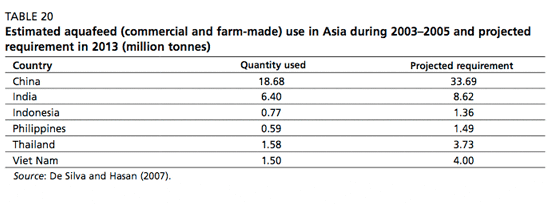
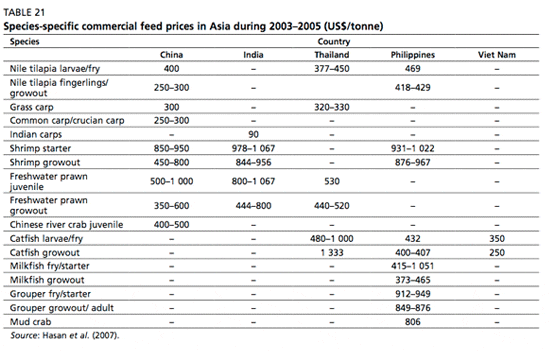
It has been reported that the feed manufacturing industry suffered from a perennial shortage of key ingredients such as fishmeal and soybean meal (AFSD–BAI, 2005). Depreciation of local currencies against the United States dollar will further increase the import cost of feed ingredients. For example, 70-90 percent of the feed cost of tilapia (US$236–309/tonne) in the Philippines in 2003 was attributed to imported feed ingredients (Sumagaysay-Chavoso, 2007). About 10 000 tonnes of fishmeal is imported into Thailand annually; there is a shortfall of soybean production of 1.68 million tonnes to meet the demands of the feed industry (Thongrod, 2007).
Volatility in commodity prices and underlying reasons
Fishmeal and fish oilFishmeal is a meal produced after cooking, pressing, drying and milling both whole fish derived from capture fisheries and food-fish trimming from fish processing plants. Fishmeal production also results in the production of fish oils. Approximately 90 percent of the fish species used to make fishmeal and oil is “presently unmarketable in large quantities as human food” (Bose et al., 1991).
In Europe, these species mainly include capelin, blue whiting, sandeel, sprat, herring and Norway pout and in South America, they include anchovy, jack mackerel and sardine. Because the supply of fishmeal and fish oil ultimately depends on capture fisheries, their supply is primarily governed by allowable quotas for these species and is subject to seasonal variation.
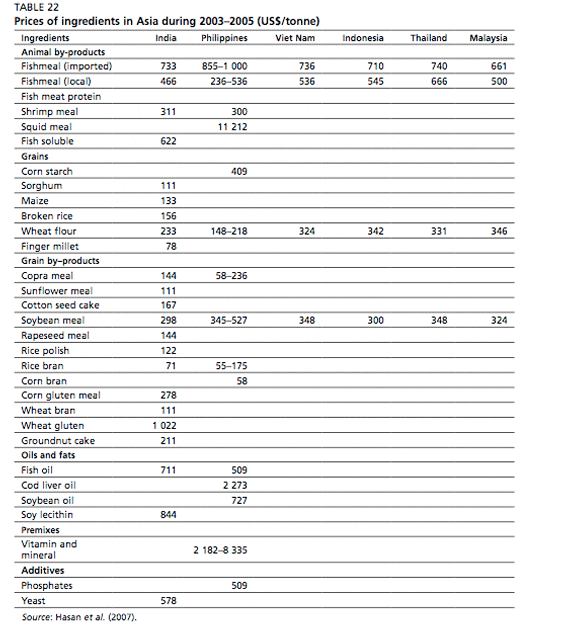
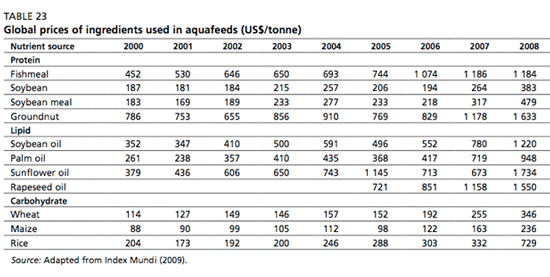
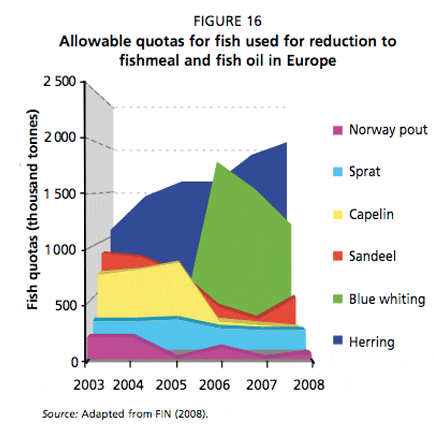

Peru and Chile in South America and Norway, Iceland and Denmark in Europe are the major countries in the world where fish are used for fishmeal and oil production. Therefore, the global fishmeal supply is affected by fish landings in these countries. These landings in turn are shaped by allowable quotas and yields, particularly of fish oil, which depend on the seasons and species composition of total landings.
The decline in landings in Europe (Figure 16) and in South America have resulted in a sharp decline in fish supply. Overall, since 2003, global fishmeal supplies from the major producing countries in 2008 declined by 780 000 tonnes. This decline was sharpest in Europe.
In Scandinavia, fishmeal availability declined from 504 000 tonnes in 2005 to 428 000 tonnes in 2008, while in South America fishmeal production declined from 2 million tonnes to 1.5 million tonnes in the same period. This production decline of suppliers combined with a sharp increase in imports by China led to escalating prices, which peaked at around US$1 300/tonne in mid-2006 (Figure 17).
Prices have slipped to some extent since then, but still are around the US$1 000 mark, about US$400 above 2003 prices. Currently, in 2009, prices are being checked by the global economic downturn and reduced demand for fishmeal from China, in particular.
The supply of fish oil also principally reflects the catch quotas for fish species used for reduction to fishmeal. The quantity or yield of oil recovered is influenced by seasonality and species composition used. Fish oil production also declined in line with fishmeal production but the proportional decline was greater owing to varying oil yields. Supplies in 2008 declined by around 40 percent from around 650 000 tonnes in 2004 to 399 000 tonnes in 2008. Following record prices of nearly US$1 800/tonne in mid-June 2008, prices have sharply declined and fish oil is selling at less than half the price of US$850/tonne (Figure 18).
The global economic downturn has also depressed the fish oil industry in 2008–2009. In addition, aquafeed producers are substituting more rapeseed oil for fish oil in their feed recipes, as the price of rapeseed began to fall. The high catch of mackerel in Iceland in late 2008 and the good yields of oil in the November 2008 fishing season in Peru, which increased inventories of fish oil, at a time of global economic downturn will most probably check price increase for fish oil.
Alternative proteins and oils used in aquafeeds
Significant progress has been made to reduce dependency on fishmeal and fish oil through the substitution of these marine raw ingredients with proteins and oils of land origin. As was the case for fishmeal and fish oil, the price increases of vegetable protein and oil mirrored those of marine ingredients, with sharp increases recorded in 2005 for soybean, corn and wheat (Figure 17), and rapeseed, palm and soybean oils (Figure 18).
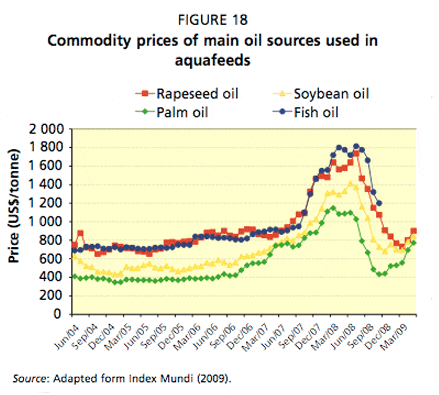
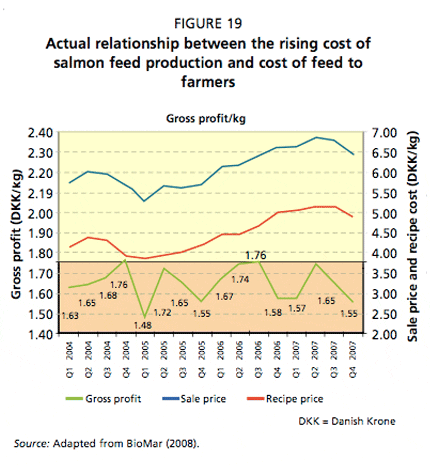
The price of corn, which has escalated from around US$100/tonne in 2004, peaked at around US$300 in June 2008 before falling to around US$180 in May 2009. The corn gluten, a protein concentrate (from the EU), used in high performance aquafeeds, however, increased from US$500/tonne in 2005 to over US$800/tonnes in November 2008. Similarly, soybean prices increased from US$200–250/tonne in 2005 and peaked at US$550 in June 2008 before declining to US$330 in March 2009. The price of protein concentrate, however, is significantly higher, escalating from around US$450/tonne in the mid-2005 to a peak of US$950/tonne in June 2008 before dropping to US$800/tonne by the end of 2008.
The use of oils of plant origin as a substitute for fish oil has significantly increased and the prices of these substitutes have also risen sharply (Figure 19). Prices of palm, soybean and rapeseed oil have gradually increased between 2004 and 2006, followed by a sharp increase in prices between 2007 and 2008 (Figure 18).
Rapeseed oil, which is the main substitute for fish oil in Europe, for example, increased from an average of US$720/tonne in 2005 to a peak of US$1 700/tonne in July 2008. Similarly, the price of palm oil used in Asia increased from US$375/tonne in 2005 to US$1 100/tonne in June 2008. Although prices have slipped since then, resurgence in demand in 2009 is forcing prices upwards again (Figure 18).
Impact of commodity prices on aquafeed costs and on farmers Rising commodity, energy and fuel costs have resulted in significant increases in the prices of manufactured and on-farm aquafeeds in Europe and Asia. For salmon, the cost of raw materials accounts for 75 percent of production costs of formulated feeds and, therefore, the overall costs and escalation of commodity prices will have a notable impact on feed prices (see Box 3). In Europe, BioMar, the third largest salmonid diet manufacturer, passed on increased costs to farmers to secure profit margins. Between 2005 and 2007, the kilogram recipe costs of salmon diets increased by 25 percent (Figure 19). To secure the required gross profit margin of around 25 percent, the sale price (per kg diet) increased by a similar fraction (Figure 19). As these price increases are due to the increased price of traded commodities, such increases are likely to apply to other major feed manufacturers in Europe as well.
The higher aquafeed costs have also affected farmers in Asia. In China, since early 2006, the price of shrimp feed has increased by US$143/tonne (RMB1 000) to US$1 060/ tonne (RMB7 400) after several rounds of price increases due to a large increase in the price of feed ingredients. However, considering the downturn of shrimp farming in 2008 and the limited capacity of shrimp farmers to bear further price increases, the shrimp feed price was only raised by RMB300 (US$43) per tonne. The difference between the production cost and price is borne by feed manufactures.
In Viet Nam, farmers and feed producers in the Mekong (Cuu Long) delta region are facing serious losses as the price of fish feed continues to rocket. In 2009, the prices of basic ingredients increased by 30 percent, raising the cost of feed by VND13 000– 13 500/kg. Rapeseed meal is a major raw material used in China as a protein substitute for fishmeal in aquafeeds and with its greater use in feeds, prices steadily increased. In 2003, prices were around RMB1 000/tonne. By April, 2009 prices almost doubled to RMB1 940/tonne.
A schematic representation of the nodal points of impacts along the product chain affected by fuels price hikes is shown in Figure 20. The sharp increases in fuel prices have impacted significantly on the cost of securing the bulk ingredients used in aquafeeds and also affected the entire production chain. The high cost of fuel has impacted on fishing vessels that land fish for production and on transport of land-based ingredients used in aquafeeds. In addition, the higher fuel and energy costs have also reduced the profit margins of fish farmers, leading to farm closures and consolidation of the sector, especially in Europe.
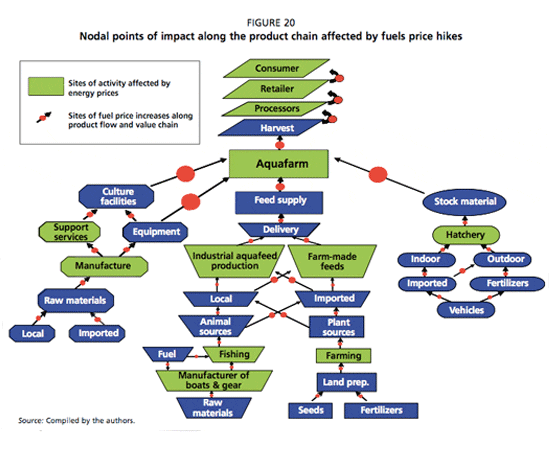
In Europe, the cost of fuel for fishing vessels has escalated dramatically. According to the EU Fisheries Commissioner, Joe Borg, the price of marine diesel has shot up 240 percent across Europe since 2004 (New Europe, 2008). Further, the European Association of Fish Producers reported a 320 percent increase in fuel prices over the last five years, and a 40 percent increase in fuel prices since January 2008. Similarly, in Latin America, the cost of fuel has skyrocketed.
In Mexico, where fuel accounts for 60 percent of a vessel’s total operating costs, the cost of diesel fuel doubled from US$0.26 in 2006 to US$0.56 in 2008 (WW4 Report, 2008). Asian fishers, who supply a significant quantity of the trash fish used in aquafeeds, were also equally affected. In the Philippines, marine fuel prices increased by 50 percent between 2007 and 2008 from PHP40 to 60 (GMA News, 2008). In Viet Nam, the prices of diesel and kerosene went up by US$0.12 and UD$0.36 to UD$0.95 and UD$1.20, respectively (Asean Affairs, 2008), while in Indonesia, the government reduced subsidies and increased fuel prices by 29 percent overnight (Asia-Pacific News, 2008).
Further Reading
| - | You can view the full report by clicking here. |
Further Reading
| - | Go to our previous news item on this story by clicking here. |

